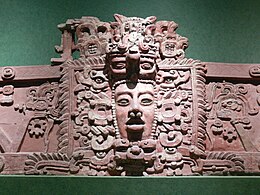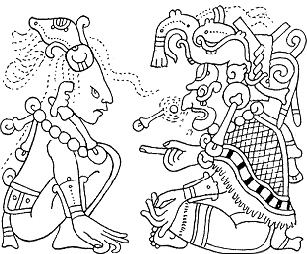
Maya or Mayan mythology is part of Mesoamerican mythology and comprises all of the Maya tales in which personified forces of nature, deities, and the heroes interacting with these play the main roles. The myths of the Pre-Hispanic era have to be reconstructed from iconography. Other parts of Mayan oral tradition are not considered here.

Tezcatlipoca was a central deity in Aztec religion, and his main festival was the Toxcatl ceremony celebrated in the month of May. One of the four sons of Ometecuhtli and Omecihuatl. The God of providence, he is associated with a wide range of concepts, including the night sky, the night winds, hurricanes, the north, the earth, obsidian, hostility, discord, rulership, divination, temptation, jaguars, sorcery, beauty, war, and conflict. His name in the Nahuatl language is often translated as "Smoking Mirror" and alludes to his connection to obsidian, the material from which mirrors were made in Mesoamerica and which were used for shamanic rituals and prophecy. Another talisman related to Tezcatlipoca was a disc worn as a chest pectoral. This talisman was carved out of abalone shell and depicted on the chest of both Huitzilopochtli and Tezcatlipoca in codex illustrations.

Xibalba, roughly translated as "place of fright", is the name of the underworld in Maya mythology, ruled by the Maya death gods and their helpers. In 16th-century Verapaz, the entrance to Xibalba was traditionally held to be a cave in the vicinity of Cobán, Guatemala. Cave systems in nearby Belize have also been referred to as the entrance to Xibalba. In some Maya areas, the Milky Way is viewed as the road to Xibalba.

Bonampak is an ancient Maya archaeological site in the Mexican state of Chiapas. The site is approximately 30 km (19 mi) south of the larger site of the people Yaxchilan, under which Bonampak was a dependency, and the border with Guatemala. While the site is not overly spatial or abundant in architectural size, it is well known for the murals located within the three roomed Structure 1. The construction of the site's structures dates to the Late Classic period. The Bonampak murals are noteworthy for being among the best-preserved Maya murals.

The Mesoamerican ballgame was a sport with ritual associations played since at least 1650 BC by the pre-Columbian people of Ancient Mesoamerica. The sport had different versions in different places during the millennia, and a newer, more modern version of the game, ulama, is still played by the indigenous populations in some places.

Yaxchilan is an ancient Maya city located on the bank of the Usumacinta River in the state of Chiapas, Mexico. In the Late Classic Period Yaxchilan was one of the most powerful Maya states along the course of the Usumacinta River, with Piedras Negras as its major rival. Architectural styles in subordinate sites in the Usumacinta region demonstrate clear differences that mark a clear boundary between the two kingdoms.
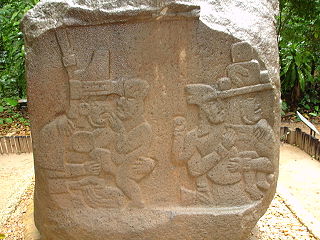
The Maya Hero Twins are the central figures of a narrative included within the colonial Kʼicheʼ document called Popol Vuh, and constituting the oldest Maya myth to have been preserved in its entirety. Called Hunahpu[hunaxˈpu] and Xbalanque[ʃɓalaŋˈke] in the Kʼicheʼ language, the Twins have also been identified in the art of the Classic Mayas. The twins are often portrayed as complementary forces. The complementary pairings of life and death, sky and earth, day and night, Sun and Moon, among multiple others have been used to represent the twins. The duality that occurs between male and female is often seen in twin myths, as a male and female twin are conceptualized to be born to represent the two sides of a single entity.
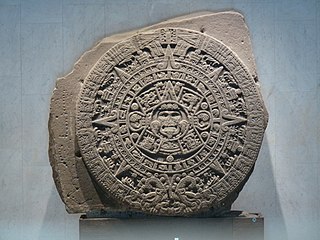
Pre-Columbian art refers to the visual arts of indigenous peoples of the Caribbean, North, Central, and South Americas from at least 13,000 BCE to the European conquests starting in the late 15th and early 16th centuries. The Pre-Columbian era continued for a time after these in many places, or had a transitional phase afterwards. Unfortunately, many types of perishable artifacts that were no doubt once very common, such as woven textiles, typically have not been preserved, but Precolumbian monumental sculpture, metalwork in gold, pottery, and painting on ceramics, walls, and rocks have survived more frequently.
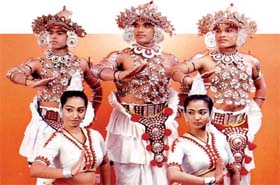
Kandyan dance encompasses various dance forms popular and native to the area called Kandy of the Central Hills region known as Udarata in Sri Lanka, which have today spread to other parts of the country. It is an example of Sinhalese culture in Sri Lanka.

The traditional Maya religion of the extant Maya peoples of Guatemala, Belize, western Honduras, and the Tabasco, Chiapas, Quintana Roo, Campeche and Yucatán states of Mexico is part of the wider frame of Mesoamerican religion. As is the case with many other contemporary Mesoamerican religions, it results from centuries of symbiosis with Roman Catholicism. When its pre-Hispanic antecedents are taken into account, however, traditional Maya religion has already existed for more than two and a half millennia as a recognizably distinct phenomenon. Before the advent of Christianity, it was spread over many indigenous kingdoms, all with their own local traditions. Today, it coexists and interacts with pan-Mayan syncretism, the 're-invention of tradition' by the Pan-Maya movement, and Christianity in its various denominations.

Ancient Maya art is the visual arts of the Mayan civilization, an eastern and south-eastern Mesoamerican culture made up of a great number of small kingdoms in present-day Mexico, Guatemala, Belize and Honduras. Many regional artistic traditions existed side by side, usually coinciding with the changing boundaries of Maya polities. This civilization took shape in the course of the later Preclassic Period, when the first cities and monumental architecture started to develop and the hieroglyphic script came into being. Its greatest artistic flowering occurred during the seven centuries of the Classic Period.

The music of the ancient Mayan courts is described through native and Spanish 16th-century texts and is depicted in the art of the Classic Period. The Maya played instruments such as trumpets, flutes, whistles, and drums, and used music to accompany funerals, celebrations, and other rituals. Although no written music has survived, archaeologists have excavated musical instruments and painted and carved depictions of the ancient Maya that show how music was a complex element of societal and religious structure. Most of the music itself disappeared after the dissolution of the Maya courts following the Spanish Conquest. Some Mayan music has prevailed, however, and has been fused with Spanish influences.

Death rituals were an important part of Maya religion. The Maya greatly respected death; they were taught to fear it and grieved deeply for the dead. They also believed that certain deaths were more noble than others.

Mayan cave sites are associated with the Mayan civilization of pre-Columbian Mesoamerica. Beliefs and observances connected with these cave sites persist among some contemporary Mayan communities. Many of the Mayan caves served religious purposes. For this reason, the artifacts found there, alongside the epigraphic, iconographic, and ethnographic studies, help build the modern-day understanding of the Mayan religion and society.
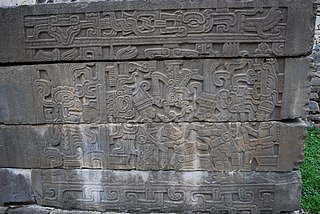
Most of the ancient civilizations of Mesoamerica such as the Olmec, Maya, Mixtec, Zapotec and Aztec cultures practiced some kind of taking of human trophies during warfare. Captives taken during war would often be taken to their captors' city-states where they would be ritually tortured and sacrificed. These practices are documented by a rich material of iconographic and archaeological evidence from across Mesoamerica.

Painting in the Americas before European colonization is the Precolumbian painting traditions of the Americas. Painting was a relatively widespread, popular and diverse means of communication and expression for both religious and utilitarian purpose throughout the regions of the Western Hemisphere. During the period before and after European exploration and settlement of the Americas; including North America, Central America, South America and the islands of the Caribbean, the Bahamas, the West Indies, the Antilles, the Lesser Antilles and other island groups, indigenous native cultures produced a wide variety of visual arts, including painting on textiles, hides, rock and cave surfaces, bodies especially faces, ceramics, architectural features including interior murals, wood panels, and other available surfaces. Many of the perishable surfaces, such as woven textiles, typically have not been preserved, but Precolumbian painting on ceramics, walls, and rocks have survived more frequently.

The Maya death gods, known by a variety of names, are two basic types of death gods who are respectively represented by the 16th-century Yucatec deities Hunhau and Uacmitun Ahau mentioned by Spanish Bishop Landa. Hunhau is the lord of the Underworld. Iconographically, Hunhau and Uacmitun Ahau correspond to the Gods A and A' . In recent narratives, particularly in the oral tradition of the Lacandon people, there is only one death god, who acts as the antipode of the Upper God in the creation of the world and of the human body and soul. This death god inhabits an Underworld that is also the world of the dead. As a ruler over the world of the dead, the principal death god corresponds to the Aztec deity Mictlantecuhtli. The Popol Vuh has two leading death gods, but these two are really one: Both are called "Death," but while one is known as "One Death," the other is called "Seven Death." They were vanquished by the Hero Twins.
Maya Ballgame, which is a branch of the Mesoamerican Ballgame, is a sporting event that was played throughout the Mesoamerican era by the Maya civilization. The Maya civilization was spread out throughout much of Central America. One of the common links of the Mayan culture of Mexico, Guatemala, Honduras, and Belize is the game played with a rubber ball, about which we have learned from several sources. Maya ballgame was played with big stone courts. The ball court itself was a focal point of Maya cities and symbolized the city's wealth and power.

During the pre-Columbian era, human sacrifice in Maya culture was the ritual offering of nourishment to the gods. Blood was viewed as a potent source of nourishment for the Maya deities, and the sacrifice of a living creature was a powerful blood offering. By extension, the sacrifice of human life was the ultimate offering of blood to the gods, and the most important Maya rituals culminated in human sacrifice. Generally, only high-status prisoners of war were sacrificed, with lower status captives being used for labor.
Performance archaeology is a subset of archaeological theory. Developers of this theory include Michael Shanks, Mike Pearson and Julian Thomas who in the 1990s at University of Wales, Lampeter began formulating concepts which view the social aspect of performance along with the artistic nature of theatre together through an interdisciplinary lens as "an integrated approach to recording, writing and illustrating the material past" thereby marrying the academic with the artistic. Performance archaeology has further expanded in the last decade upon the theories of presence. Geoff Bailey states that "because we believe that the present is known or knowable better than the past, we must seek our inspiration in studies of present phenomena and our concepts and theories from authorities on the present." Michael Shanks along with Ian Hodder, Christopher Witmore, Gabriella Giannachi and Nick Kaye have recently expanded the theory further by calling for cooperation within the humanities and studying transdisciplinary research from archaeologists who are encouraged to become storytellers in order to more diversely analyze the engagement of the actor, the audience, the things and the space in which they perform by using an 'ecology of practices'. The theory of performance archaeology aims to give researchers a multi temporal link to the antiquated through studying the processual nature of "performance of presence" which is entangled within the 'multipleness' of time. Echoing theories posited by Martin Heidegger, the processual and temporal natures of performance are phenomenologically entwined with the experiences of the performers and audience. Stories are preserved by memory through performance. These performances can be seen both in the archaeological record as well in modern enactments or rituals. The landscape itself is an integral portion of performance memory. Performance archaeology sets itself apart from performance history by directing focus not toward the past itself but instead toward what has become of the past by taking an ethnoarchaeological approach of analyzing the 'archaeology of present' cultures which allows for a richer interpretation of past performance. Performance archaeology takes a cross-disciplinary approach with 'social archaeology' to studying the things, narratives or artifacts, that remain of ancient theatre, music, dance, art history and oral tradition in order to 'model the past'. The following examples illustrate components that might aptly demonstrate aspects of performance archaeology.
